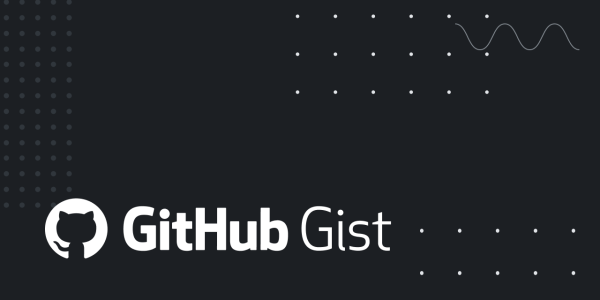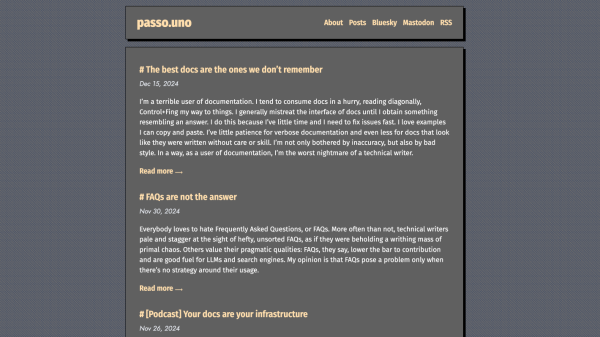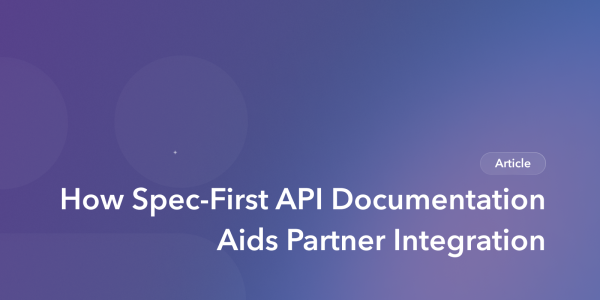Suche
Beiträge, die mit DocsAsCode getaggt sind
I have appended a brief guide to the main/broad categories of documentation toolsets and some of the platforms/components that are popular in each.
Finally, this resource ends with a table of possible solutions for various scenarios you might find yourself in.
Before we start with the existing list of questions, I want to highlight one that I think is most important of all, but which is often assumed by people who create these kinds of guides, as they tend to come from one or another world already.
What are you documenting?
When it comes to software technical writing, the more appropriate way to ask this might be: For what user roles is your documentation intended?
For graphical end-user interfaces (GUIs), the largest range of docs tooling is available, but here some of the more commercial turnkey tools have most of their advantages.
For administrator interfaces (installation, configuration, etc), again any tooling will work, but we start seeing real advantages for lightweight markup, codebase integration, and version control.
For developer interfaces, docs-as-code offers significant advantages. Developers can better contribute directly, and it’s generally friendlier for coded samples. APIs (native and remote), SDKs, and CLIs are almost certainly best documented in a docs-as-code environment, even if you integrate it with a more conventional platform for end-user docs."
https://gist.github.com/briandominick/d4cbe11228de0ebe31cda630976af4ef
#TechnicalWriting #SoftwareDocumentation #Documentation #DocsAsCode #TechnicalCommunication #InformationArchitecture #CCMS
Here is some more context to help you decide on an approach and get started."
https://gist.github.com/briandominick/3ffab6be460fbde799aa34e0a42a4299
#API #APIs #APIDesign #REST #APIDocumentation #OpenAPI #DocsAsCode #TechnicalWriting #TechnicalCommunication

API Documentation Decision Matrix
API Documentation Decision Matrix. GitHub Gist: instantly share code, notes, and snippets.Gist
#APIs #APIDocumentation #Markdown #TechnicalWriting #Git #DocsAsCode
https://apichangelog.substack.com/p/three-elements-of-a-good-api-readme

Three Elements of a Good API README
Sometimes, offering an API README is enough. What are the elements that make it good?Bruno Pedro (The API Changelog)
There are exceptions to this, of course. The first is documentation that is presented in such a way that it generates a “Wow” moment. Perhaps it’s a code snippet you can run, an interactive demo, or similar gimmicks. While they’re not key to great documentation, they make for some memorable experiences, though that can backfire quickly if the docs aren’t good. The other exception are docs that teach us something new, either through conceptual explanations or examples. Some of the best docs I’ve read are aware that they’re also teaching new ideas and concepts. You can tell because they grin."
https://passo.uno/my-favorite-tech-docs/
#TechnicalWriting #SoftwareDocumentation #Docs #DocsAsCode #SoftwareDevelopment

What I say when someone asks me what are my favorite docs
I’m a terrible user of documentation. I tend to consume docs in a hurry, reading diagonally, Control+Fing my way to things. I generally mistreat the interface of docs until I obtain something resembling an answer.passo.uno
In the end, the business effects of specification-driven development are manifold. Whether you're building RESTful, GraphQL, or event-driven partner services, having reliable API documentation is important to compete in the digital economy. This consistency equates to a better partner experience, leading to stickier partners and less customer churn. By enabling smoother integrations and reducing frustration, spec-first documentation directly contributes to partner retention and loyalty, which ultimately drives revenue growth."
https://bump.sh/blog/how-spec-first-api-documentation-aids-partner-integration
#APIs #APIDocumentation #TechnicalWriting #SpecFirst #SoftwareDocumentation #Docs #DeveloperExperience #DocsAsCode

How Spec-First API Documentation Aids Partner Integration · Bump.sh
Partner APIs are far more common than public-facing APIs. Yet, inaccessible documentation for these APIs is often a big barrier to partner success.bump.sh

